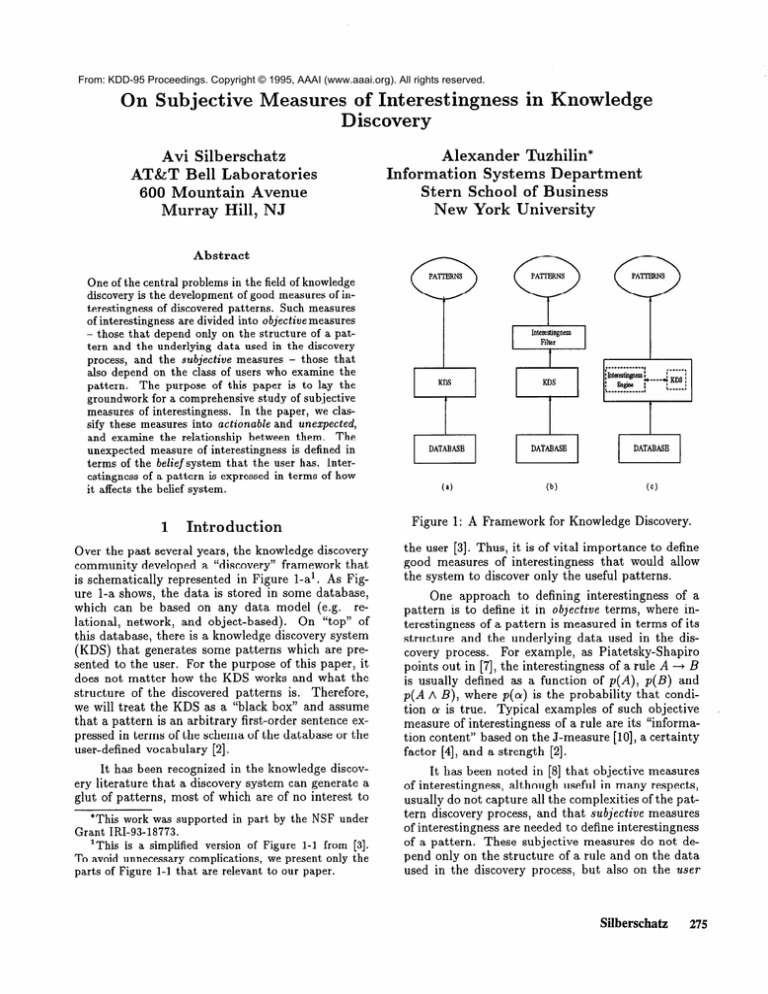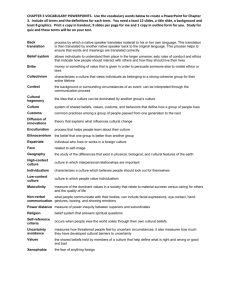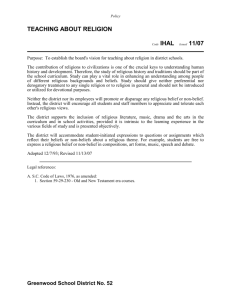
From: KDD-95 Proceedings. Copyright © 1995, AAAI (www.aaai.org). All rights reserved.
On Subjective
Measures
of Interestingness
Discovery
Avi Silberschatz
AT&T
Bell Laboratories
600 Mountain
Avenue
Murray
Hill, NJ
in Knowledge
Alexander
Tuzhilin*
Information
Systems Department
Stern School of Business
New York University
Abstract
One of the central problems in the field of knowledge
discovery is the development of good measures of interestingness of discovered patterns. Such measures
of interestingness are divided into objective measures
- those that depend only on the structure of a pattern and the underlying data used in the discovery
process, and the subjective measures - those that
also depend on the class of users who examine the
pattern.
The purpose of this paper is to lay the
groundwork for a comprehensive study of subjective
measures of interestingness.
In the paper, we classify these measures into actionable and unexpected,
and examine the relationship
between them. The
unexpected measure of interestingness
is defined in
terms of the belief system that the user has. Interestingness of a pattern is expressed in terms of how
it affects the belief system.
1
Introduction
Over the past several years, the knowledge
discovery
community developed a “discovery” framework that
is schematically represented in Figure l-a’. As Figure l-a shows, the data is stored in some database,
which can be based on any data model (e.g. relational, network, and object-based).
On “top” of
this database, there is a knowledge discovery system
(KDS) that g enerates some patterns which are presented to the user. For the purpose of this paper, it
does not matter how the KDS works and what the
structure of the discovered patterns is. Therefore,
we will treat the KDS as a “black box” and assume
that a pattern is an arbitrary first-order sentence expressed in terms of the schema of the database or the
user-defined vocabulary [2].
It has been recognized in the knowledge discovery literature that a discovery system can generate a
glut of patterns, most of which are of no interest to
*This work was supported in part by the NSF under
Grant IRI-93-18773.
‘This is a simplified version of Figure l-l from [3].
To avoid unnecessary complications,
we present only the
parts of Figure l-l that are relevant to our paper.
I
(a)
Figure 1: A Framework
I
I
I
(cl
(‘-‘I
for Knowledge
Discovery.
the user [3]. Thus, it is of vital importance to define
good measures of interestingness that would allow
the system to discover only the useful patterns.
One approach to defining interestingness of a
pattern is to define it in objective terms, where interestingness of a pattern is measured in terms of its
structure and the underlying data used in the discovery process. For example, as Piatetsky-Shapiro
points out in [7], the interestingness of a rule A + B
is usually defined as a function of P(A), p(B) and
p(A A B), where p(o) is the probability
that condition CYis true. Typical examples of such objective
measure of interestingness of a rule are its “information content” based on the J-measure [lo], a certainty
factor [4], and a strength [2].
It has been noted in [8] that objective measures
of interestingness, although useful in many respects,
usually do not capture all the complexities of the pattern discovery process, and that subjective measures
of interestingness are needed to define interestingness
of a pattern. These subjective measures do not depend only on the structure of a rule and on the data
used in the discovery process, but also on the user
Silberschatz
275
who examines the pattern. These measures recognize
that a pattern that is of interest to one user, may be
of no interest to another user. For example, a pattern discovering some security trading irregularities,
such as insider trading, may be of great interest to
the officials from the Securities and Exchange. Commission (SEC). H owever, it is of very little use to a
homeless person living in New York City.
In [8], subjective measures of interestingness
were studied within the context of the discovery system KEFIR [6] that analyzes healthcare insurance
claims for uncovering “key findings.” The lcey findings in KEFIR are the most important changes from
the norms for various indicators assessing different
characteristics of provision of healthcare, such as
cost, usage, and quality. The authors in [8] argue
that “a good measure of the interestingness of a finding is the estimated benefit that could be realized by
taking a specific action in response.” Since the KEFIR system deals with the financial data pertaining
to the insurance claims, it measures benefits in financial terms. KEFIR classifies all possible findings into
a predefined set of types, each type defined in terms
of some logical condition imposed on one or several
indicators. KEFIR then defines a production rule for
each type of finding that specifies the actions to be
taken in response to the findings that typically indicate how to bring “abnormal” indicators back to their
norms. Moreover, the domain expert needs to assign
a probability of success to t]he actions in the rule.
Once a new finding is discovered, the system determines all the production rules matching this finding
and selects the rule with the highest probability of
success. It then computes the estimated benefit of
taking the action for the selected rule as potential
savings realized from the action restoring the deviation back to its norm. This estimated benefit serves
as a measure of interestingness in KEFIR.
tern is interesting
point of view:
l
l
from the subjective
(user-oriented)
Unexpectedn .ess - a pattern is interesting if it is
“surprising” to the user.
ActionabiZity - a pattern is interesting if the user
can do something with it to his or her advantage.
This is, essentially, the subjective measure of interestingness studied in [8].
We also examine the relationship between these two
measures of interestingness with the emphasis on the
first measure.
Once the concept of interestingness is defined, it
can be incorporated into the KBS in one of the following two ways. First of all, an interestingness filter can
be developed and placed at the buck-end of the KBS
module (see Figure l-b). In this case, the KDS generates many patterns that are put through the filter
that selects only few “interesting” patterns. Alternatively, an interestingness engine can be placed inside
the KBS module so that it can focus the search only
on the interesting patterns (see Figure l-c). Clearly,
the second approach is preferred since it avoids generating many non-interesting patterns, thus, speeding
the discovery process.
The purpose of this paper is to lay the groundwork for a comprehensive study of domain independent subjective measures of interestingness.
The
main emphasis of the paper is on the attempt to understand, at the intuitive level, what these measures
are and how they are related to each other. Having this goal in mind, we do not attempt to provide
a complete treatment of this issue. We believe that
this topic is sufficiently rich and, thus, would require
a communal effort that goes well beyond the scope
of a single paper.
2
Measures
of Interestingness
The method used in KEFIR provides a good
approach for defining a subjective measure of interestingness in terms of the benefits accrued from the
corrective actions bringing deviated measures back to
their norms. This approach, however, is very domain
specific for the following reasons. First, it deals only
with patterns expressed as deviations (changes of an
indicator from its norm).
Second, it pre-classifies
all the patterns that can be discovered into a finite
(hopefully small) set of classes in order to assign a
corrective action to each class. This is possible in
case of KEFIR because it deals with a very domainspecific problem related to healthcare.
Thirdly, it
makes several domain-specific assumptions about the
way estimated benefits are computed.
As pointed out in the introduction,
it is important
to study not only objective, but also subjective measures of interestingness of patterns because a pattern
that is of interest to one user may be of no interest
to another one. We identify two reasons why a pattern can be interesting to a user from the subjective
point of view. It is either because the pattern is unexpected or because it is actionable. We now explain,
at the intuitive level, what these two concepts mean
and also explore how they are related to each other.
We will base our discussions of these two subjective
measures of interestingness on the following example
that will be used throughout the paper.
In this paper, we also study subjective measures
of interestingness.
However, unlike [8], we study
them in a domain-independent
context. In particular, we propose a classification of measures of interestingness and identify two major reasons why a pat-
Example
1 Consider the database of student evaluations of different courses offered at some university. Each semester, students do evaluations of all the
courses they take, and the summaries of these evaluations are stored in the database as reports shown in
276
KDD-95
Strong
Percentage
,,isagr,,,,,,,,,,,t
The
Instructor:
(1 - lJ,
The Course:
1. The
instructor
presented
2.
The
instructor
stimulated
3. The
instructor
explained
4. The
instructor
responded
5. The
instructor
was
6. The
instructor
course
provided
The
instructor
graded
fairly
instructor
provided
11.
There
12.
The
class
sessions
13.
This
was
a demanding
14.
The
material
15.
The text
and other
16.
Overall,
I would
sufficient
was
class
1 learned
will
reading
recommend
7.7
42.3
30.5
0.0
15.4
11.5
30.5
23.1
............
5.4
1.3
0.0
7.7
0.0
1.7
26.9
34.6
15.4
............
6.1
0.0
0.0
0.0
0.0
3.0
11.5
50.0
30.0
......................
.................................
useful
to
materials
this
were
course
me ........................
worthwhile
6
3.0
........................................
be
s
0.0
...........................
participation
4
7.7
1.3
.........................
instructor
2
0.0
0.9
........................
feedback
2
0.0
Strong
Agreement
1.
6.2
..
.......................................
worthwhile
course
comments
1
Responding
5.6
fashion
...........
.........................
students
in
this
were
and
examples
sufficient
recommend
effectively
questions
practical
0.
would
course
....................................
an interest
f
the
-----_---------------
S.D.
--
0.0
organized
an
in
concepts
to
showed
Overall,
in
interest
enthusiastic
The instructor
10.
materials
difficult
7.
9. The
(11 -G)
student
well
-Mean
...............
.............................
6.4
0.0
0.0
0.0
0.0
3.0
7.7
26.9
53.0
6.0
1.0
0.0
0.0
3.0
3.0
15.4
34.6
34.6
6.2
1.1
0.0
0.0
3.0
7.7
0.0
30.5
46.2
5.0
1.4
3.0
0.0
0.0
11.5
11.5
26.9
30.5
5.0
1.0
0.0
0.0
3.0
3.0
19.2
42.3
19.2
6.4
0.9
0.0
0.0
3.8
0.0
3.0
34.6
50.0
5.6
5.0
1.0
0.9
0.0
0.0“
0.0
0.0
0.0
15.4
26.9
30.0
23.1
0.0
3.0
30.5
26.9
26.9
5.9
1.0
0.0
0.0
0.0
11.5
15.4
42.3
30.0
5.0
1.3
0.0
0.0
7.7
11.5
11.5
26.9
30.5
5.3
1.6
7.7
0.0
3.0
7.7
26.9
26.9
23.1
5.7
1.5
3.0
0.0
0.0
11.5
11.5
26.9
30.0
Figure 2: A Course-Faculty Evaluation Report.
Figure 2. These reports are generated every semester
for every course offered at that university. 0
2.1
Actionability
Measure
According to this measure, a pattern is interesting
because the user can do something about it; that
is, the user can react to it to his or her advantage.
For example, the pattern that Professor X is consistently getting the overall instructor ratings (item 10
in Figure 2) below the overall course ratings (item
16 in Figure 2) can be of great interest to the chairperson of the department where X teaches because
this shows to the chairperson that Professor X has
“room” for improvement in his or her teaching ratings and X should be encouraged to work more on
his teaching and presentation skills.
Actionability
is an important subjective measure of interestingness because users are mostly interested in the knowledge that permits them to do
their jobs better by taking some specific actions in
response to the newly discovered knowledge. However, it is not the only important subjective measure
of interestingness, as we discuss it in the next section.
exclaimed “Oh, this is interesting...”
when we discover something unexpected?).
For example, if in
most of the course evaluations, the overall instructor
ratings (item 10) are higher than the overall course
ratings (item 16)) and it turns out that in most of
Professor X’s ratings overall instructor evaluations
are lower than the overall course evaluations then
such a pattern is unexpected and, hence, interesting.
As another example, assume that in some course only
8% of the students responded with their evaluations,
whereas this number is normally between 60% and
90%. This pattern is definitely interesting because it
is certainly unexpected.
We maintain that unexpected patterns are interesting because they contradict our expectations
which, in turn, depend on our system of beliefs.
For example, in the “instructor evaluation” pattern
above, we believe that the overall instructor ratings
should be higher than the overall course ratings,
whereas the pattern contradicts this belief. Similarly, the “response rate” pattern contradicts our belief that there should be a “reasonable” response rate
from the students.
2.3
2.2
Unexpectedness
Measure
If a newly discovered pattern is surprising to the user,
then it is certainly interesting (how many times we
Relationship
Unexpectedness
Between
and
Actionability
Clearly, some patterns are unexpected and actionable at the same time. For example, the “instructor
Silberschatz
277
Measures of Interedingness
with a belief system, the more unexpected and hence
the more interesting it is. Thus, to define interestingness of a pattern, we have to define beliefs first.
3.1
Actionability
Unexpecte4lness
Figure 3: Classification
evaluation” pattern
the same time.
of Interestingness
is actionable
Measures.
and unexpected
at
Furthermore, some actionable patterns can be
expected. For example, assume Professor Y is getting
consistently high ratings, and the chairperson of the
department wants to nominate him for the ‘(Teacher
of the Year” award. However before doing so, the
chairperson wants to see the latest evaluations for
Professor Y, and it turns out that they are also good.
Such pattern (good student evaluations for Professor
Y in the last semester) is expected. However, it is
also actionable because the chair can nominate Professor Y for the award now without any reservations.
Also, a pattern can be unexpected and nonactionable.
For example, the “response rate” pattern of only 8% is unexpected.
However, it is not
actionable for the chairperson of the department offering this course because student response rates are
beyond his or her control and cannot be influenced
by the chairperson in any way.
Thus, we can conclude that the two subjective
measures of interestingness, “unexpectedness” and
“actionability”
of a pattern are, in general, independent of each other 2. This conclusion leads to the classification of measures of interestingness as presented
in Figure 3.
Both unexpectedness and actionability measures
are important. However, we consider only unexpectedness for the remainder of the paper, leaving actionability as a topic of future research.
3
Defining
Unexpectedness
Systems
via Belief
As indicated in Section 2.2, unexpectedness is related
to beliefs. Intuitively, the more a pattern disagrees
2Although we believe that most unexpected patterns
are also actionable and most actionable patterns are
unexpected.
278
KDD-95
Beliefs
Beliefs and belief revision have been extensively studied in AI. In particular, there are two major approaches to defining beliefs and belief revision. In
the first approach, based on the work of Alchourron
et al. [l] and others, we either believe in something
or we don’t. When a new belief is considered, it is
either added to the set of previous beliefs in case it
does not contradict them, or some of the previous beliefs have to be removed to accommodate a new one
in case it contradicts some of the previous beliefs.
In contrast to the first approach, the second approach to the theory of beliefs and belief revision assumes that we can believe in certain statements only
partially. In other words, it assigns some degree or
measure, or a confidence factor to each belief. The
two most prominent approaches to assigning such a
measure to a belief are the Bayesian approach [5] and
the the Dempster-Shafer theory of evidence approach
[9]. In the Bayesian approach, the degree of belief is
associated with the conditional probability that the
belief holds given some previous “evidence” for this
belief, whereas in the Dempster-Shafer theory a belief
function [9] is assigned to beliefs which, in general,
does not satisfy the axioms of probability theory.
In this paper, we follow the second approach and
associate some confidence measure with each belief.
We also assume that beliefs are arbitrary predicate
formulae expressed in first-order logic. In addition,
we assume that there are two types of beliefs, hard
and soft beliefs, which are defined below.
Soft Beliefs.
These are beliefs that the user is willing to change as new patterns are discovered that
provide the user with new evidence.
For example, the belief that the overall instructor ratings are
higher than the overall course ratings is a soft belief because it can be changed as new evidence (new
grades) is reported every semester. We assign a degree (or measure) to each soft belief that specifies
our “confidence” in it. Furthermore, we will adopt
the Bayesian approach and assume that the degree
of belief is measured with the conditional probability [S]. This means that if a is a belief and [ is the
previous evidence “supporting” that belief, then the
degree of belief in cy is P(Q ] S). For example, cv can
be the belief that “the overall instructor ratings are
higher than the overall course ratings,” and 5 can
be the “evidence” consisting of all the instructor and
course ratings over several semesters of studies and
over all the courses offered by that university.
Given new evidence E, we update the degree of
belief in o, P(a]E,<), using the Bayes rule:
Example
2 Let oc be the belief that “the overall
instructor ratings are higher than the overall course
ratings,” and assume that the degree of this belief
is 0.85 (P(c~cl~) = 0.85). Assume that a new course
evaluation arrived containing a new evidence Ec that
the overall instructor rating (item 10 in Figure 2)
for the course taught by this instructor is 5.8 and
the overall course rating (item 16 in Figure 2) is
5.2. We associate two functions with belief cyc comy[t,g
the conditional probabilities P(Elacl r> and
loc,e) for evidence E. Assume that it turns
out that for the new evidence Ec P(Eclac,[)
= 0.62
and P(E~~YQ,<) = 0.42. Then, substituting these
numbers into (l), we compute P(aclEc,~) = 0.89. 0
and if p is a pattern (that is also a logical sentence),
then if BH k lp, then pattern p is interesting. Note
that a contradicting pattern does not affect hard beliefs and that hard beliefs are kept unchanged. Such
a contradiction means that the data used to derive
the pattern must be wrong. For example, in the “response rate” pattern described in Section 3.1 something must have been wrong with the data because
the number of responding students cannot be greater
than the number of students registered for the course.
Soft Beliefs.
Based on our previous discussion of
the intuitive meaning of interestingness, we formally
define interestingness of pattern p relative to a (soft)
belief system B as
I(P> B)
=
c
W r>l
pb4t)
IP(4P, r> -
crEB
(2)
The Bayesian degree of belief defined above has
the following properties that follow directly from the
definitions:
where the sum is taken over all of the soft beliefs cy
in B. This definition of interestingness measures by
how much a new pattern p changes degrees of our
beliefs.
Property
1. Positive evidence strengthens the belief: if Q b E then P((Y 1 E,e) > P((Y 1 [). 0
Example
Property
2. Negative evidence weakens the belief:
if cy b 1E then P(CY I E,J) 5 P(CY I r>. O
The hard beliefs are the constraints
Hard Beliefs.
that cannot be changed with new evidence. In fact,
if new evidence contradicts these beliefs, then there
must be some mistakes made in acquiring this new
evidence. For example, if it turns out that the number of students responding to the evaluation survey
is greater than the number of students registered for
that class (two items in the upper-left corner of the
evaluation report in Figure 2), then it means that
the accuracy of this report is highly questionable and
that its data is wrong. We would like to stress that
hard beliefs, as soft beliefs, are subjective and vary
from one user to another. Also, we do not associate
any degree with hard beliefs because the user never
changes beliefs of this type.
3.2
Interestingness
of a Pattern
Relative
to a Belief
System
3
In Example 2, it was shown that if
0.85 then P(cuolEo,<) = 0.89. Substituting these numbers into (2), we obtain the interestingness of the pattern Ec (that in the new facultycourse evaluation report the instructor ratings (5.8)
were higher than the course ratings (5.2)) relative to
belief (~0 as I(&,ac)
= 0.047.
P((YoIO=
Assume that the evaluation report described
in Example 2 has the overall course rating of 5.8
and the overall instructor rating 5.2 (we will denote
this evidence El). Assume that it turns out that
P(J%
bo, r> = 0.42 and P(El(lcuo, <) = 0.62. Then
P(arJlE1, <) = 0.79 and, substituting these numbers
into (2), we obtain I(.&, MJ) = 0.076. 0
Note that in Example 3 the pattern that contradicts the belief that instructor ratings are usually higher than the course ratings is more interesting than the pattern that confirms this belief (since
0.047 = .I(,!&, ac) < I(&, CYO)= 0.076). This observation, that unexpected patterns are more interesting
than expected patterns, is formalized in the following
theorem.
As we stated in Section 2.2, intuitively, a pattern is
interesting relative to some belief system if it “affects” this system, and the more it “affects” it, the
more interesting the pattern is. We distinguish between hard and soft beliefs, and thus treat these two
cases separately.
Theorem
1 Let CY be a belief, such that 0.5 <
P(cY~~) < 1. Let p be a pattern confirming belief
a ~CXk p). Also assume that the function evaluatN-7 P(Pb, 5) is symmetric with respect to CY,that
is for allp, P(lpla, [) = P(plx~, 6). Then I(p, CY)5
I(lp, CY)~. Moreover, the equality holds if and only if
If a pattern contradicts the set of
Hard Beliefs.
hard beliefs of the user then this pattern is always
interesting to the user. In other words, if BH is a
set of logical sentences defining hard beliefs of a user
P(Pl% I) = P(lPl% r>.
3Note that pattern p is expected in this context because it follows from CYand up is unexpected because it
contradicts cy.
Silberschatz
279
Patterns
Hard
soft
Contradictory
change data
check data
Non-contradictory
accept data
accept data
Figure 4: Actions to be Taken With the Data When a New Pattern is Discovered.
Patterns
Beliefs
Hard
soft
Contradictory
do nothing
depends on the data check (see text)
Non-contradictory
do nothing
update degree of belief
Figure 5: Actions to be Taken With Beliefs When a New Pattern is Discovered.
Sketch of Proof: It follows from Properties 1 and
2 that, to prove the theorem, we should show that
PblP> 0 + wT4
2
0 < P@ls>
-
Substituting formula (1) into this expression and using the symmetry properties P(lpla, t) = P(P~Tx, S)
and P(Pl%S) = P(~~JTx,J), this inequality is re0
duced to (P(pla, 0 - P(lpl~, [))2 2 0.
4
How Discovered
Patterns
Beliefs and the Underlying
Affect
Data
In Section 3, we defined interestingness of a pattern
in terms of its unexpectedness.
In this section, we
examine what should be done with the belief system
and with the underlying data on which the pattern
is based, once an unexpected pattern is discovered.
In order to understand the actions that need to
be taken, we divide the beliefs into hard and soft and
the discovered patterns into the ones that contradict
the beliefs and the ones that do not contradict them.
The actions to be taken with respect to the underlying data when an unexpected pattern is discovered are summarized in Figure 4. In particular, if a
discovered pattern contradicts the hard beliefs, then
this means that the underlying data on which the
pattern is based is wrong and needs to be changed.
For example, as was pointed out in Section 3.1, if
the number of students responding to the evaluation
survey is greater than the number of students registered for the course, this means that something is
wrong with the data and that the data should be
changed appropriately.
If the pattern does not contradict hard or soft beliefs, then the data should be
left unchanged (accepted).
Moreover, if a pattern
contradicts a soft constraint, then it is an indication
that the data should be possibly checked. For example, if we have a soft belief that cars are usually
280
KDD-95
driven at a speed of 50 to 80 mph on American freeways, and if we discover that somebody has driven a
distance of 250 miles in two hours (which contradicts
our soft belief), then we may want to check the data
to make sure that there are no mistakes made in the
process of recording this data.
The actions to be taken with respect to the belief system when an unexpected pattern is discovered
are summarized in Figure 5. In particular, if the
discovered pattern contradicts the hard beliefs, then
there is nothing one can do to these beliefs because
these beliefs are unchangeable constraints (laws), and
the data supporting the pattern must be wrong. If
the pattern does not contradict the hard beliefs then,
clearly, nothing needs to be done with these beliefs.
If the pattern contradicts the soft beliefs, then, as we
pointed out before, a check may be necessary to test
whether the pattern is based on the correct data. If
it is based on the wrong data, then the beliefs remain
intact. If the pattern is based on the correct data,
then the degrees of soft beliefs should be updated as
specified in Section 3.1. Finally, if the pattern does
not contradict soft beliefs then the degrees of soft
beliefs should be updated as specified in Section 3.1.
5
Future
Research
Directions
Since the purpose of this paper is to stimulate a discussion in the knowledge discovery community about
the subjective measures of interestingness, we presented only the overall approach to subjective measures of interestingness and did it mostly informally.
We plan to proceed with a formal study of these concepts only after some consensus among the KDD researchers is reached on the intuitive meanings of various measures of interestingness.
There are many important questions that have
to be addressed in order to better understand subjective measures of interestingness. First, how to for-
P(alS)
1
are important.
As a starting point, we studied unexpectedness in this paper, leaving actionability as a
topic of future research. To define interestingness in
terms of unexpectedness, we considered a belief system and defined interestingness of a pattern in terms
of how much it affects the belief system.
Acknowledgments
We thank Gregory Piatetsky-Shapiro
for useful discussions of some of the issues addressed in the paper.
Figure 6: Relationship Between the Degree of Belief
and the “Measure of Evidence.”
malize actionability
and understand better how it is
related to unexpectedness.
Second, how to compute
interestingness of a pattern relative to a belief system
and how to do this efficiently. Third, how to maintain a belief system in an efficient manner. Fourth,
what should the structure of a belief system be, and
how it affects the computations of interestingness of
a pattern. Fifth, how would subjective and objective
measures of interestingness be combined into one integral measure. Sixth, how can we use the belief
systems discussed in this paper to discover incorrect
and corrupted data (i.e. how can we do “data cleaning”). Seventh, formalize the relationship between
the degree of belief and the “measure of evidence.”
Intuitively, if there is neither supporting nor contradicting evidence for some belief o, then the degree of
belief is P(o 1 s) = 0.5, where P(cu 1 6) is a conditional probability and [ is a supporting evidence. In
this case the “measure of evidence,” I[1 = 0. Intuitively, the relationship between P((Y 1 <) and ISI is
as shown in Figure 6 - the more supporting evidence
t for CYthere is, the closer P(o I S) is getting to 1,
and similarly, the more there is negative evidence 5
for belief CY’the
, more P(o I 0 approaches 0. One of
the important issues is to find a good measure of evidence, It 1, and then, possibly, redefine the measure
of interestingness (2) in terms of ISI.
These are just a few questions that need to be
addressed in order to understand subjective measures
of interestingness better, and we believe that we took
the first step towards this goal by raising all of these
issues in the paper.
6
Conclusions
We classified different measures of interestingness of
patterns into objective and subjective and identified
two subjective reasons why a pattern can be interesting to the user - either because it is unexpected or
because it is actionable. We also argued, at the intuitive level, that these two measures of interestingness
are independent of each other and that both of them
References
PI C. Alchourron,
P. Gardenfors, and D. Makinson.
On the logic of theory change: Partial meet contraction and revision functions. Journal of Symbolic Logic, 50:510-530, 1985.
PI V.
Dhar and A. Tuzhilin. Abstract-driven
pattern discovery in databases. IEEE Transactions
on Knowledge and Data Engineering, 5(6), 1993.
PI W.J.
Frawley, G. Piatetsky-Shapiro,
and C.J.
Mat heus. Knowledge discovery in databases:
an overview.
In G. Piatetsky-Shapiro
and
W.J. Frawley, editors, Knowledge Discovery in
Databases. AAAI / MIT Press, 1991.
PI J. Hong and C. Mao. Incremental discovery
of rules and structure by hierarchical and parallel clustering.
In G. Piatetsky-Shapiro
and
W.J. Frawley, editors, Knowledge Discovery in
Databases. AAAI / MIT Press, 1991.
PI E. J. Horvitz, J. S. Breese, and M. Henrion. Decision theory in expert systems and artificial intelligence. Journal of Approximate Reasoning,
2, July 1988.
and
PI C. J. Matheus, G. Piatetsky-Shapiro,
D. .McNeill.
An application of KEFIR to the
analysis of healthcare information.
In Proceedings of the AAAI-94
Workshop on Knowledge
Discovery in Databases, 1994.
VI G. Piatetsky-Shapiro. Discovery, analysis, and
presentation of strong rules. In G. PiatetskyShapiro and W.J. Frawley, editors, Knowledge
Discovery in Databases. AAAI / MIT Press,
1991.
PI G. Piatetsky-Shapiro and C. J. Matheus. The
interestingness of deviations. In Proceedings of
the AAAI-94
Workshop on Knowledge Discovery in Databases, pages 25-36, 1994.
PI G. Shafer. A mathematical theory of evidence.
Princeton University Press, 1976.
[101P. Smyth and R. M. Goodman. Rule induction using information theory. In G. PiatetskyShapiro and W.J. Frawley, editors, Knowledge
Discovery in Databases. AAAI / MIT Press,
1991.
Silbcrschatz
281





